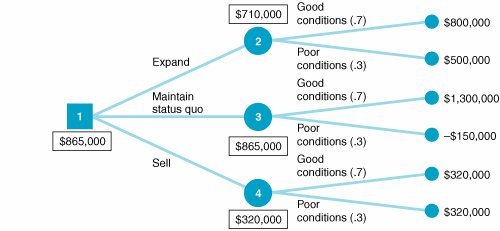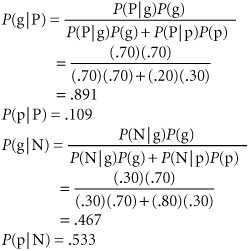Example Problem Solution
| State of Nature | ||
|---|---|---|
| Decision | Good Foreign Competitive Conditions | Poor Foreign Competitive Conditions |
| Expand | $ 800,000 | $ 500,000 |
| Maintain status quo | 1,300,000 | 150,000 |
| Sell now | 320,000 | 320,000 |
-
Determine the best decision by using the following decision criteria:
-
Maximax
-
Maximin
-
Minimax regret
-
Hurwicz ( a = .3)
-
Equal likelihood
-
-
Assume that it is now possible to estimate a probability of .70 that good foreign competitive conditions will exist and a probability of .30 that poor conditions will exist. Determine the best decision by using expected value and expected opportunity loss.
-
Compute the expected value of perfect information.
-
Develop a decision tree, with expected values at the probability nodes.
-
T. Bone Puckett has hired a consulting firm to provide a report on future political and market situations. The report will be positive (P) or negative (N), indicating either a good (g) or poor (p) future foreign competitive situation. The conditional probability of each report outcome, given each state of nature, is
P (Pg) = .70
P (Ng) = .30
P (Pp) = .20
P (Np) = .80
Determine the posterior probabilities by using Bayes's rule.
-
Perform a decision tree analysis by using the posterior probability obtained in (e).
Solution
| Step 1. | (part A): Determine Decisions Without Probabilities
Decision: Maintain status quo.
Decision: Expand.
Decision: Expand.
Decision: Expand.
Decision: Expand. | ||||||||||||||||||||||||||||||||||||||||||||||||||||
| Step 2. | (part B): Determine Decisions with EV and EOL
Decision: Maintain status quo.
Decision: Maintain status quo. | ||||||||||||||||||||||||||||||||||||||||||||||||||||
| Step 3. | (part C): Compute EVPI
| ||||||||||||||||||||||||||||||||||||||||||||||||||||
| Step 4. | (part D): Develop a Decision Tree  | ||||||||||||||||||||||||||||||||||||||||||||||||||||
| Step 5. | (part E): Determine Posterior Probabilities | ||||||||||||||||||||||||||||||||||||||||||||||||||||
| | |||||||||||||||||||||||||||||||||||||||||||||||||||||
| Step 6. | (part F): Perform Decision Tree Analysis with Posterior Probabilities | ||||||||||||||||||||||||||||||||||||||||||||||||||||
EAN: 2147483647
Pages: 358
 Maximum
Maximum 
